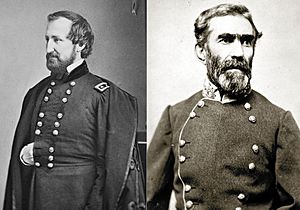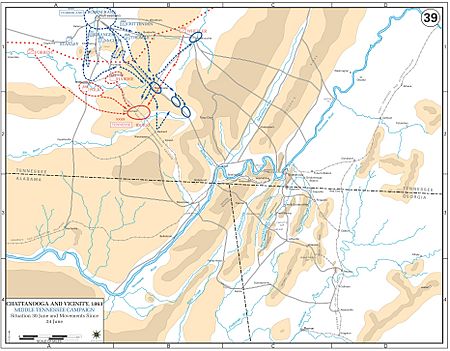Tullahoma campaign facts for kids
Quick facts for kids Tullahoma campaign |
|||||||
|---|---|---|---|---|---|---|---|
| Part of the American Civil War | |||||||
 Commanding generals Rosecrans and Bragg |
|||||||
|
|||||||
| Belligerents | |||||||
| Commanders and leaders | |||||||
| William Rosecrans | Braxton Bragg | ||||||
| Strength | |||||||
| 50,000–60,000 | about 45,000 | ||||||
| Casualties and losses | |||||||
| 569 (83 killed, 473 wounded, and 13 captured or missing) | Total unknown, 1,634 captured | ||||||
The Tullahoma campaign was a smart military plan during the American Civil War. It happened from June 24 to July 3, 1863. The Union forces, led by Major General William Rosecrans, pushed the Confederates out of Middle Tennessee. This move also threatened the important city of Chattanooga.
The Confederate army, led by General Braxton Bragg, had a strong defensive spot in the mountains. But Rosecrans used clever tricks to capture key mountain passes. His soldiers also used new seven-shot Spencer repeating rifles. The Confederates had problems among their generals and lacked supplies. Soon, they had to leave their main base at Tullahoma.
This campaign ended in the same week as two big Union wins: the Battle of Gettysburg and the Siege of Vicksburg. Rosecrans felt his success was not noticed enough. However, Bragg's army did not lose many soldiers. They soon got more troops and later defeated Rosecrans at the Battle of Chickamauga.
Contents
Why the Campaign Happened
After a tough battle at Stones River in early 1863, General Bragg moved his Confederate army south. They set up defenses along the Duck River and behind the Highland Rim ridge. This area was almost 70 miles wide. Bragg's main concern was that Rosecrans would try to take Chattanooga. This city was a vital railroad hub and a gateway to northern Georgia.
Bragg thought the Union attack would come from his left side, near Shelbyville. So, he placed a large group of soldiers there, led by Lieutenant General Leonidas Polk. Eight miles to the right, Lieutenant General William J. Hardee's troops were at Wartrace. They protected the main road to Chattanooga and other passes. One pass, Hoover's Gap, was barely defended. It was a narrow, four-mile-long path between tall ridges.
Rosecrans kept his army in Murfreesboro for almost six months. He used this time to get more supplies and train his soldiers. He also built a strong fort called Fortress Rosecrans. Leaders like President Abraham Lincoln and Secretary of War Edwin M. Stanton urged him to attack Bragg. But Rosecrans waited, partly because of the muddy winter roads. The government worried that Bragg might send troops to help fight against Union Major General Ulysses S. Grant at Vicksburg, Mississippi. Lincoln wanted Rosecrans to keep Bragg busy.
Bragg's army also faced problems. The land they occupied was poor farmland, making it hard to find food. Even though they were protecting food supplies, many soldiers were hungry. Meanwhile, much of the South's food went to General Robert E. Lee's army in Virginia.
Some of Bragg's generals were unhappy with his leadership. Confederate President Jefferson Davis sent General Joseph E. Johnston to check on the army. Johnston found the army in good shape and refused to take command from Bragg.
Both sides sent cavalry (soldiers on horseback) on raids during the winter and spring. These raids often didn't achieve much. Confederate cavalry, like those led by Major General Joseph Wheeler and Brigadier General Nathan Bedford Forrest, tried to cut Union supply lines. But they lost many men. The Union also lost soldiers in these raids.
By June, Union leaders were very frustrated with Rosecrans's delays. General-in-Chief Henry Halleck threatened to remove him if he didn't move. Rosecrans finally agreed to move in about five days. On June 24, 1863, the Union Army of the Cumberland began its advance against Bragg.
Armies in the Campaign
Union Forces
The Union Army of the Cumberland, led by Major General Rosecrans, had about 50,000 to 60,000 soldiers. Here are its main parts:
- XIV Corps, led by Major General George Henry Thomas. It had 26,058 soldiers.
- XX Corps, led by Major General Alexander McDowell McCook. It had 16,047 soldiers.
- XXI Corps, led by Major General Thomas Leonidas Crittenden. It had 17,023 soldiers.
- Reserve Corps, led by Major General Gordon Granger. It had 20,615 soldiers.
- Cavalry Corps, led by Major General David S. Stanley. It had 12,281 soldiers.
Confederate Forces
The Confederate Army of Tennessee, led by General Bragg, had about 45,000 soldiers. Here are its main parts:
- Polk's Corps, led by Lieutenant General Leonidas Polk. It had 14,260 soldiers.
- Hardee's Corps, led by Lieutenant General William J. Hardee. It had 14,949 soldiers.
- Wheeler's Cavalry Corps, led by Major General Joseph Wheeler. It had 8,967 soldiers.
- Forrest's Cavalry Division, led by Brigadier General Nathan B. Forrest. It had 4,107 soldiers.
The Campaign in Action
The campaign started on June 23. Union soldiers under General Granger moved west from Murfreesboro. This was a trick to make Bragg think the main attack would be on his left side, near Shelbyville. At the same time, another Union group moved far to the right, aiming for Manchester. This would put them behind the Confederates. Rosecrans told his commanders the full plan only after these first moves began.
Rosecrans's plan was clever. While Bragg focused on Shelbyville, General Thomas's corps would march southeast. They would head for Hoover's Gap, on Bragg's right side. This gap was not well guarded, so speed was very important.
Rosecrans had asked for more cavalry but was denied. Instead, he got permission to turn an infantry group into a mounted unit. This was Colonel John T. Wilder's brigade, known as the "Lightning Brigade." They found horses and mules and armed themselves with seven-shot Spencer repeating rifles. This gave them great speed and firepower.
Our regiment lay on the hill side in mud and water, the rain pouring down in torrents, while each shell screamed so close to us as.... Presently the enemy got near enough to us to make a charge on our battery, and on they came; our men are on their feet in an instant and a terrible fire from the "Spencers" causes the advancing regiment to reel and its colors fall to the ground, but in an instant their colors are up again and on they come, thinking to reach the battery before our guns can be reloaded, but they "reckoned without their host," they didn't know we had the "Spencers," and their charging yell was answered by another terrible volley, and another and another without cessation... and but few men of that 20th Tennessee that attempted the charge will ever charge again.
Wilder's brigade quickly reached Hoover's Gap and captured it on the first day. This earned them their "Lightning Brigade" nickname. Confederate cavalry tried to stop them but failed. Even though Wilder's main support was far behind, he decided to hold the gap. Confederate troops attacked, but the Spencer rifles' strong fire drove them back. Wilder's brigade held the gap until more Union soldiers arrived. General Thomas praised Wilder, saying, "You have saved the lives of a thousand men by your gallant conduct today."
At Liberty Gap, six miles west, a similar fight happened. Union soldiers, also mounted and armed with Spencer rifles, found only two Confederate regiments there. They attacked quickly, pushing through the gap. A tough fight followed, but Union troops gained ground.
The first day of the campaign had heavy rain, which lasted for 17 days. This slowed the Union advance. But the Union army had perfectly carried out Rosecrans's plan. They now held two key passes and could attack Bragg's right side.
On June 25, Confederates tried to retake Hoover's Gap and Liberty Gap but failed. Rosecrans paused his army's movement because of the muddy roads. During this time, Bragg did not react well. His cavalry commanders were not giving him good information. They didn't report the Union's main movements.
Bragg realized on June 26 that the main Union attack was on his right. He ordered Polk's corps to march and attack the Union at Liberty Gap from behind. But Polk thought the task was too hard. Bragg eventually called off the attack. Meanwhile, Rosecrans ordered his troops to move around the Highland Rim and use the opening at Hoover's Gap.
Hardee, another Confederate general, also caused problems for Bragg. He complained about the Tullahoma position. He ordered his troops at Hoover's Gap to retreat towards Wartrace. This made it easier for the Union army to advance. By June 27, Bragg had no choice but to order Polk and Hardee to retreat to Tullahoma.
Wilder's Brigade reached Manchester on June 27. Other Union divisions followed. In the west, Union cavalry easily pushed back Confederates at Shelbyville. Colonel Robert H. G. Minty led his "Saber Brigade" in a charge over the Confederate defenses.
On June 28, Wilder's brigade went on a raid to damage the railroad behind Bragg's army. They rode south to Decherd. The Elk River was high from the rain. They took apart a nearby mill to build a raft and float their cannons across. They defeated a small Confederate group, tore up railroad tracks, and burned a depot full of Confederate food. They then destroyed another rail line near Sewanee. Wilder's brigade returned to Manchester by June 30, without losing a single man.
Bragg was not too worried about the railroad damage, as it was quickly fixed. His men waited in their Tullahoma forts for a Union attack. But Polk worried about the army's supply lines being cut. He told Bragg to retreat. Hardee also didn't encourage Bragg to stay and fight. So, on June 30, Bragg ordered a nighttime retreat across the Elk River. By leaving before the Union attack, Bragg missed a chance to hurt the Union army.
The Confederate army moved south to Cowan. Bragg was tired and sick from the stress. The Cowan position was not good for defense. So, on July 3, Bragg ordered a full retreat to Chattanooga. His army crossed the Tennessee River on July 4. Union cavalry tried to catch them but failed. By July 7, all Confederate units were near Lookout Mountain.
What Happened Next
Thus ended a nine days' campaign, which drove the enemy from two fortified positions and gave us possession of Middle Tennessee, conducted in one of the most extraordinary rains ever known in Tennessee at that period of the year.
Many historians call the Tullahoma campaign "brilliant." Abraham Lincoln said it was "the most splendid piece of strategy I know of." Union General David Stanley called it a "model campaign." The Union army had pushed the Confederates out of Middle Tennessee with very few losses. The Union had 569 casualties (83 killed, 473 wounded, 13 captured or missing). Bragg did not report his losses, saying they were "trifling." But the Union army captured 1,634 Confederates. Bragg later said the campaign was "a great disaster."
Rosecrans did not get much public praise for his victory. The campaign ended on the same day Robert E. Lee lost the Battle of Gettysburg. The next day, Vicksburg surrendered to Grant. Secretary of War Stanton sent Rosecrans a message, urging him to "give the finishing blow to the rebellion." Rosecrans was angry. He replied that his army had already driven the Confederates from Middle Tennessee. He felt his army's achievement was being overlooked.
Rosecrans did not immediately chase Bragg. He paused to regroup and plan for fighting in the mountains. When the fighting started again, Bragg's army was stronger. With new troops, Bragg attacked Rosecrans at the Battle of Chickamauga in September. Bragg won, which was the only major Confederate victory in the Western Theater of the war. He pushed Rosecrans back to Chattanooga and surrounded him there.




